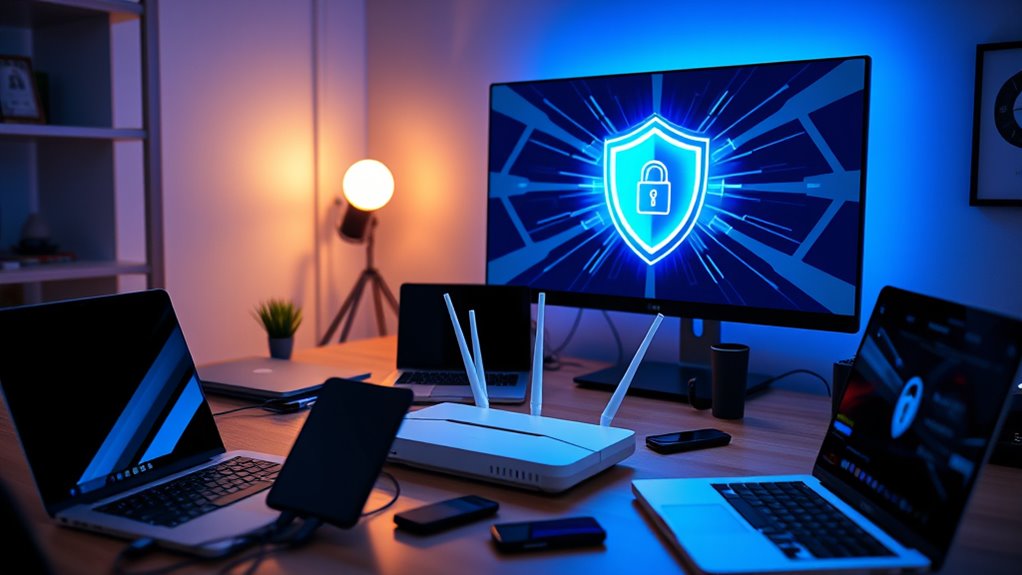To protect your home network from hackers, start strong by using complex passwords and changing default credentials immediately. Keep your device software and firmware updated regularly to patch vulnerabilities. Use security tools like firewalls, VPNs, and network segmentation to limit access. Enable multi-factor authentication and monitor network activity for unusual behavior. Secure your WiFi with strong encryption and hide your SSID. Setting up guest networks and maintaining detailed logs also boost security—continue exploring to learn more effective tips.
Key Takeaways
- Change default router credentials and disable SSID broadcasting to prevent easy network identification.
- Enable WPA3 or WPA2 encryption with a strong, unique password for your WiFi network.
- Keep firmware and software updated regularly to patch security vulnerabilities.
- Segment your network with guest and IoT networks to limit access to critical devices.
- Use a firewall and intrusion detection system to monitor and block suspicious activity.

Securing your home network is crucial in today’s digital landscape, where cyber threats are constantly evolving. You need to take proactive steps to protect your devices, data, and privacy from hackers. One of the most effective ways to do this is by using strong passwords. Create complex combinations of letters, numbers, and special characters for all your network devices. Avoid default credentials, and change them immediately when setting up new devices. To manage passwords more efficiently, consider employing a password manager. These tools generate, store, and autofill complex passwords securely, reducing the risk of reuse or weak passwords. Implement multi-factor authentication (MFA) whenever possible. MFA adds an extra layer of security by requiring a second verification step, such as a code sent to your phone, making unauthorized access much more difficult.
Keeping your software and firmware up to date is equally critical. Regularly check for updates and enable automatic updates for your operating system and applications. Firmware updates often include patches for security vulnerabilities that hackers could exploit. Make it a habit to periodically verify that your network devices, like routers and switches, are running the latest firmware. Patch known vulnerabilities promptly to prevent potential breaches. Managing your devices actively helps you stay ahead of security threats, ensuring all components are current and protected. Additionally, understanding the contrast ratio of your projector can help you optimize your home cinema setup for better picture quality in various lighting conditions.
Utilize network security tools to enhance your defenses. Install both software and hardware firewalls to monitor and restrict unauthorized access. Keep your antivirus, anti-spyware, and anti-malware software updated and run regular scans. When accessing your home network remotely, use a virtual private network (VPN) to encrypt your internet traffic. Segmenting your network into different zones—for example, separating your smart devices from your computers—limits the potential damage if one device gets compromised. For added security, consider deploying intrusion detection systems that monitor traffic for suspicious activity.
Proper network configuration and documentation are essential. Record all network settings and changes, and maintain an inventory of connected devices. Keep detailed logs of security incidents, updates, and backups. Regularly back up your critical data and verify that your backup systems function correctly. Proper documentation makes troubleshooting easier and helps you respond swiftly to any security incident.
Finally, secure your WiFi network by enabling WPA3 encryption or WPA2 with a robust password. Change default router usernames and passwords immediately upon setup. Avoid using public WiFi for sensitive activities unless you connect through a VPN. Consider hiding your network’s SSID to reduce visibility to outsiders and set up a separate guest network for visitors, isolating your main devices. Conduct regular penetration testing and security audits to identify vulnerabilities. Monitoring your network traffic for unusual activity and inspecting devices for unauthorized access further strengthens your defenses. Developing an incident response plan ensures you’re prepared to act swiftly if a breach occurs. By implementing these measures, you considerably reduce the risk of hackers compromising your home network.
Frequently Asked Questions
How Often Should I Update My Router’s Firmware?
You’re wondering how often to update your router’s firmware. It’s best to check every few months for updates, or enable automatic updates if available. Stay alert for security alerts and follow the manufacturer’s recommended schedule. Regular updates improve security, fix bugs, and enhance performance. Plan updates during off-peak hours to avoid disruptions. Always verify updates first and avoid rushing, as faulty updates can cause issues or device bricking.
Can Using a VPN Improve My Home Network Security?
Did you know that using a VPN can reduce your chances of cyber attacks by encrypting your internet traffic? When you use a VPN, it hides your IP address and secures your data, making it harder for hackers to target you. While it doesn’t block malware or phishing, combining a VPN with other security tools considerably improves your home network’s protection and privacy. It’s a smart step toward safer browsing.
What Are the Risks of Using Public Wi-Fi Networks?
Using public Wi-Fi networks exposes you to several risks. Hackers can intercept your unencrypted data, stealing sensitive information like passwords, bank details, or location history. They may distribute malware or ransomware to compromise your devices. Attackers can hijack your sessions or set up fake hotspots to trap you. Without proper security, your personal data and online accounts are vulnerable, making public Wi-Fi a risky environment for your privacy and security.
How Do I Detect if My Network Has Been Hacked?
Detecting a hacked network is like spotting a leak in a boat before it sinks. You should look for signs such as slowed internet, unexplained device activity, or browser redirects. Use detection tools like intrusion systems or monitor for unusual login activity and data changes. Keep an eye on resource spikes and unauthorized software. Regularly update your devices and change passwords to stay ahead of potential threats.
Are Smart Home Devices More Vulnerable to Hacking?
Yes, smart home devices are more vulnerable to hacking. Over 99% of attacks exploit common vulnerabilities, with devices like TVs, smart plugs, and DVRs facing frequent threats. Hackers often use these weak points to launch DDoS and malware attacks, which are increasing rapidly. To protect yourself, keep firmware updated, use strong passwords, and segment your network to limit exposure and reduce risks.
Conclusion
Remember, your home network is basically an open invitation to hackers—because who doesn’t love a surprise guest? But really, by following these tips, you’re making it just a little less tempting. Think of it as locking your door, but for your Wi-Fi. So go ahead, tighten those security measures, and sleep a little easier knowing you’ve outsmarted the cyber-ghosts. Or at least made their job a tiny bit harder. Your hacker-free home awaits!










